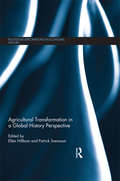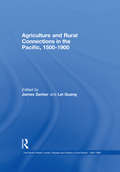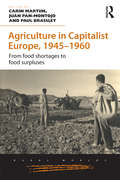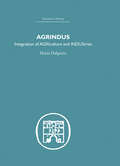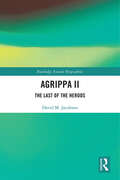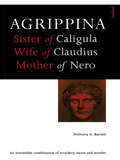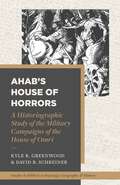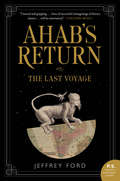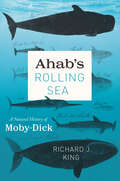- Table View
- List View
Agricultural Transformation in a Global History Perspective (Routledge Explorations in Economic History)
by Ellen Hillbom Patrick SvenssonHistory teaches us that agricultural growth and development is necessary for achieving overall better living conditions in all societies. Although this process may seem homogenous when looked at from the outside, it is full of diversity within. This book captures this diversity by presenting eleven independent case studies ranging over time and space. By comparing outcomes, attempts are made to draw general conclusion and lessons about the agricultural transformation process.
Agriculture and Economic Growth in England 1650-1815 (Routledge Library Editions: Agribusiness and Land Use #15)
by E. L. JonesOriginally published in 1967, this was the first book to discuss why agricultural supply became more ‘responsive’ and to provide broadly based evidence of the ways in which that ‘responsiveness’ may have influenced the growth of the economy. The editor chose 7 essays, reprinted in full, to illustrate altered perspectives of agricultural change. His substantial introduction places the beginnings of a significant rise in farm output as far back as the mid-seventeenth century and concludes that agriculture played a vital but complicated role in the economy of eighteenth-century England.
Agriculture and Korean Economic History: Concise Farming Talk (Nongsa chiksǒl)
by Seong Ho JunThis book is an economic history of the Chosŏn dynasty (1392-1910). The Chosŏn dynasty is not only known for managing the northeastern regions of Asia for 500 years as the exemplars of Confucianism, their kingdom was also one of the greatest so-called “agricultural states under Heaven.” The Chosŏn dynasty has been briefly explored academically by Western scholars, but their findings have some limitations. The period of 1400-1600, in particular, has been too poorly reported on in the English language to gain the attention of the Western knowledge society. This book aims to fill the gaps in the existing research and will be of interest to economists, scholars of Korean history, agriculturists, and ecologists.
Agriculture and Rural Connections in the Pacific (The Pacific World: Lands, Peoples and History of the Pacific, 1500-1900)
by Lei GuangAgriculture and Rural Connections in the Pacific brings together key studies from across several disciplines to examine the history of trans-Pacific rural and agricultural connections and to show an agriculturally-oriented Pacific World in the making since the 1500s. Historical globalization is commonly understood as a process that is propelled by industry or commerce, yet the seeds of global integration - literally as well as metaphorically - were sown much earlier, when crops and plants dispersed, agricultural systems proliferated, and rural people migrated across oceans. One goal of this volume is to demonstrate that the historical processes of globalization contained an agrarian dimension in which sub-national and national spaces were shaped in part through the influence of forces that originated in distant lands. Social and economic trends emanating from outside local territories had large impacts on demographic change, choices of agrarian systems, and the cropping patterns in many domestic settings. A second goal is to encourage readers to abandon the traditional Euro-centric view of events that shaped the Pacific region. The modern history of the Pacific World was undoubtedly shaped by Western imperialism, colonialism, and European trade and migration, but the present volume seeks to balance the interpretation of those forces with an emphasis on the increasing intensity of trans-Pacific interactions through rural labor migration and agricultural production.
Agriculture and the Confederacy
by R. Douglas HurtIn this comprehensive history, R. Douglas Hurt traces the decline and fall of agriculture in the Confederate States of America. The backbone of the southern economy, agriculture was a source of power that southerners believed would ensure their independence. But, season by season and year by year, Hurt convincingly shows how the disintegration of southern agriculture led to the decline of the Confederacy's military, economic, and political power. He examines regional variations in the Eastern and Western Confederacy, linking the fates of individual crops and different modes of farming and planting to the wider story. After a dismal harvest in late 1864, southerners--faced with hunger and privation throughout the region--ransacked farms in the Shenandoah Valley and pillaged plantations in the Carolinas and the Mississippi Delta, they finally realized that their agricultural power, and their government itself, had failed. Hurt shows how this ultimate lost harvest had repercussions that lasted well beyond the end of the Civil War.Assessing agriculture in its economic, political, social, and environmental contexts, Hurt sheds new light on the fate of the Confederacy from the optimism of secession to the reality of collapse.
Agriculture and the Great Depression: The Rural Crisis of the 1930s in Europe and the Americas (Perspectives in Economic and Social History)
by Gérard Béaur Francesco ChiapparinoWhat role did the agricultural sector play in the economic crash of 1929? Taking evidence from country cases across Europe and the Americas, this edited volume explores short-, medium- and long-term perspectives on the primary sector. The monograph brings together the voices of an international panel of contributors who examine issues such as falling prices, industrial production, unemployment and the stagnation of aggregate demand. Together, they frame the interwar period as a pivotal turning point in the decline of subsistence agriculture and the growth of agricultural subsidies, which remain a key policy tool in many economies today. This illuminating book will be of interest to advanced students and researchers in economic history, agricultural history, globalization, and economic development.
Agriculture in Capitalist Europe, 1945–1960: From food shortages to food surpluses (Rural Worlds)
by Carin Martiin Juan Pan-Montojo Paul BrassleyIn the years before the Second World War agriculture in most European states was carried out on peasant or small family farms using technologies that relied mainly on organic inputs and local knowledge and skills, supplying products into a market that was partly local or national, partly international. The war applied a profound shock to this system. In some countries farms became battlefields, causing the extensive destruction of buildings, crops and livestock. In others, farmers had to respond to calls from the state for increased production to cope with the effects of wartime disruption of international trade. By the end of the war food was rationed when it was obtainable at all. Only fifteen years later the erstwhile enemies were planning ways of bringing about a single agricultural market across much of continental western Europe, as farmers mechanised, motorized, shed labour, invested capital, and adopted new technologies to increase output. This volume brings together scholars working on this period of dramatic technical, commercial and political change in agriculture, from the end of the Second World War to the emergence of the Common Agricultural Policy in the early 1960s. Their work is structured around four themes: the changes in the international political order within which agriculture operated; the emergence of a range of different market regulation schemes that preceded the CAP; changes in technology and the extent to which they were promoted by state policy; and the impact of these political and technical changes on rural societies in western Europe.
Agriculture in World History (Themes in World History)
by Mark B. TaugerCivilization from its origins has depended on the food, fibre, and other commodities produced by farmers. In this unique exploration of the world history of agriculture, Mark B. Tauger looks at farmers, farming, and their relationships to non-farmers from the classical societies of the Mediterranean and China through to the twenty-first century. Viewing farmers as the most important human interface between civilization and the natural world, Agriculture in World History examines the ways that urban societies have both exploited and supported farmers, and together have endured the environmental changes and crises that threatened food production. Accessibly written and following a chronological structure, Agriculture in World History illuminates these topics through studies of farmers in numerous countries all over the world from Antiquity to the contemporary period. Key themes addressed include the impact of global warming, the role of political and social transformations, and the development of agricultural technology. In particular, the book highlights the complexities of recent decades: increased food production, declining numbers of farmers, and environmental, economic, and political challenges to increasing food production against the demands of a growing population. This wide-ranging survey will be an indispensable text for students of world history, and for anyone interested in the historical development of the present agricultural and food crises.
Agriculture in World History (Themes in World History)
by Mark B. TaugerNow in its second edition, Agriculture in World History presents a unique exploration of farmers and farming, and their relationships to non-farmers and urban societies from the ancient world to the 21st century. From its origins, civilization has depended on the food, fiber, and other goods produced by farmers. This book illustrates how urban societies both exploited and supported farmers, and together endured economic and environmental crises. Viewing farmers as the crucial interface between civilization and the natural world, Mark Tauger examines the environmental changes, political and social transformations, and scientific and technological developments in farming. The second edition draws attention to the modern period, particularly the effects of war, depression, and authoritarianism on world agriculture, scientific advances and the problems they created, increased international competition between countries with the expanding role of corporations, the threats posed by climate change, and some of agriculture's future prospects. Accessibly written and following a chronological structure, the volume enables readers to easily gain a foundational understanding of an important aspect of world history. This survey will be an indispensable text for world history students and for anyone interested in the historical development of the present agricultural and food crises.
Agriculture in the Midwest, 1815–1900
by Prof. R. Douglas HurtAfter the War of 1812 and the removal of the region&’s Indigenous peoples, the American Midwest became a paradoxical land for settlers. Even as many settlers found that the region provided the bountiful life of their dreams, others found disappointment, even failure—and still others suffered social and racial prejudice. In this broad and authoritative survey of midwestern agriculture from the War of 1812 to the turn of the twentieth century, R. Douglas Hurt contends that this region proved to be the country&’s garden spot and the nation&’s heart of agricultural production. During these eighty-five years the region transformed from a sparsely settled area to the home of large industrial and commercial cities, including Chicago, Milwaukee, Cleveland, and Detroit. Still, it remained primarily an agricultural region that promised a better life for many of the people who acquired land, raised crops and livestock, provided for their families, adopted new technologies, and sought political reform to benefit their economic interests. Focusing on the history of midwestern agriculture during wartime, utopian isolation, and colonization as well as political unrest, Hurt contextualizes myriad facets of the region&’s past to show how agricultural life developed for midwestern farmers—and to reflect on what that meant for the region and nation.
Agriculture, Resource Exploitation, and Environmental Change (An Expanding World: The European Impact on World History, 1450 to 1800 #17)
by Helen WheatleyThis volume examines the ecological consequences of European expansion as a result of land use and resource exploitation. These environmental transformations could be as dramatic as the last Ice Age, but scholars have only begun to take full measure of the changes. The articles presented here provide a map of some of the more promising directions of historical research. Major themes include biological exchange, agriculture, extraction of forest and animal resources, interactions between indigenous and European methods of exploitation, and European approaches to regulation and conservation. A useful corrective to the frontier image of Europeans conquering the wilderness, this volume provides a rich picture of the diversity of European interests and the sometimes unexpected consequences of their approaches to the land.
Agrindus: Integration of AGRIculture and INDUStries
by Haim HalperimThis is a fascinating insight into some of the most important thinking of the industrial revolution in Israel. Technological revolution, rapid industrialization and higher levels of productivity all drew more and more people from the agricultural workforce and new ideas were needed to combat this serious loss of labour. At the time this book was first published, Professor Halperim's had somthing new and original to offer. He argued that agriculture could be combined with industry without undermining that age-old social asset, the village community, and bring it into line with changing conditions. As he predicted the development of areas comprising a score or more of villages, ranging around non-agriculture has been preserved, and rural society has continued to exist although it has assumed different forms. The name proposed by the author for this new formation is Agrindus, as it expresses the integration of AGRiculture and INDUStries.
Agrippa II: The Last of the Herods (Routledge Ancient Biographies)
by David JacobsonAgrippa II is the first comprehensive biography of the last descendant of Herod the Great to rule as a client king of Rome. Agrippa was the last king to assume responsibility for the management of the Temple in Jerusalem, and he ultimately saw its destruction in the Judaean-Roman War. This study documents his life from a childhood spent at the Imperial court in Rome and rise to the position of client king of Rome under Claudius and Nero. It examines his role in the War during which he sided with Rome, and offers fresh insights into his failure to intervene to prevent the destruction of Jerusalem and its Sanctuary, as well as reviewing Agrippa’s encounter with nascent Christianity through his famous interview with the Apostle Paul. Also addressed is the vexed question of the obscurity into which Agrippa II has fallen, in sharp contrast with his sister Berenice, whose intimate relationship with Titus, the heir to the Roman throne, has fired the imagination of writers through the ages. This study also includes appendices surveying the coins issued in the name of Agrippa II and the inscriptions from his reign. This volume will appeal to anyone studying Judaean-Roman relations and the Judaean-Roman War, as well as those working more broadly on Roman client kingship, and Rome’s eastern provinces. It covers topics that continue to attract general interest as well as stirring current scholarly debate.
Agrippa's Daughter: A Novel
by Howard FastAn epic novel of Berenice, Queen of Israel—life, love, and war in the shadow of the Roman Empire—from the New York Times–bestselling author of Spartacus. Throughout her rule in the first century AD, Queen Berenice is idolized by some, and hated by others. Though her fiery red hair makes her instantly recognizable, it is her mysterious charm and steely will that make her unforgettable. The daughter of Israel&’s King Agrippa I, Berenice is determined to free the kingdom of Israel from the shadow of the Roman Empire. But her plans are derailed after her husband, Shimeon, dies during a bloody civil war. When Berenice falls in love with Titus, son of the Roman Emperor, they devise an impossible plan to join the ruling lines of Rome and Israel. A master of gripping historical fiction, Howard Fast brings the ancient world to vivid life in this enthralling, epic drama.This ebook features an illustrated biography of Howard Fast including rare photos from the author&’s estate.
Agrippina: Mother of Nero (Roman Imperial Biographies)
by Anthony A. BarrettIn this dynamic new biography - the first on Agrippina in English - Professor Barrett uses the latest archaeological, numismatic and historical evidence to provide a close and detailed study of her life and career. He shows how Agrippina's political contribution to her time seems in fact to have been positive, and that when she is judged by her achievements she demands admiration. Revealing the true figure behind the propaganda and the political machinations of which she was capable, he assesses the impact of her marriage to the emperor Claudius, on the country and her family. Finally, he exposed her one real failing - her relationship with her son, the monster of her own making to whom, in horrific and violent circumstances, she would eventually fall victim.
Agrippina: The Most Extraordinary Woman Of The Roman World
by Emma SouthonSister of Caligula. Wife of Claudius. Mother of Nero. The story of Agrippina, at the center of imperial power for three generations, is the story of the Julio-Claudia dynasty—and of Rome itself, at its bloody, extravagant, chaotic, ruthless, and political zenith. In her own time, she was recognized as a woman of unparalleled power. Beautiful and intelligent, she was portrayed as alternately a ruthless murderer and helpless victim, the most loving mother and the most powerful woman of the Roman empire, using sex, motherhood, manipulation, and violence to get her way, and single-minded in her pursuit of power for herself and her son, Nero. This book follows Agrippina as a daughter, born in Cologne, to the expected heir to Augustus’s throne; as a sister to Caligula who raped his sisters and showered them with honors until they attempted rebellion against him and were exiled; as a seductive niece and then wife to Claudius who gave her access to near unlimited power; and then as a mother to Nero—who adored her until he had her assassinated. Through senatorial political intrigue, assassination attempts, and exile to a small island, to the heights of imperial power, thrones, and golden cloaks and games and adoration, Agrippina scaled the absolute limits of female power in Rome. Her biography is also the story of the first Roman imperial family—the Julio-Claudians—and of the glory and corruption of the empire itself.
Agrotropolis: Youth, Street, and Nation in the New Urban Guatemala
by J.T. WayIn Agrotropolis, historian J. T. Way traces the developments of Guatemalan urbanization and youth culture since 1983. In case studies that bring together political economy, popular music, and everyday life, Way explores the rise of urban space in towns seen as quintessentially "rural" and showcases grassroots cultural assertiveness. In a post-revolutionary era, young people coming of age on the globally inflected city street used popular culture as one means of creating a new national imaginary that rejects Guatemala's racially coded system of castes. Drawing on local sources, deep ethnographies, and the digital archive, Agrotropolis places working-class Maya and mestizo hometowns and creativity at the center of planetary urban history.
Aguas Envenenadas
by Noris La Valle Ermisenda AlvarezErrores sangrientos, cicatrices desagradables y hermosas mentiras. Una historia de corrupción. Helen Gardener es asesinada durante un viaje transatlántico. El Diamond Royale zarpa desde Southampton hacia Nueva York con su asesino a bordo. Ambientada en los años 50, Aguas Envenenadas nos cuenta la historia de siete desafortunados personajes y la forma en que se ven afectados por su muerte. ¿Fue simplemente un accidente? El señor Phillips, dueño del barco y anfitrión del crucero, gobierna con puño de hierro y está tras la búsqueda de algo o de alguien. Las mentiras crecen fuera de control mientras los sospechosos tratan de sobrevivir los últimos días a bordo. Confrontados con su propio sentido de la moralidad, de la avaricia y de la lujuria, descubren qué clase de personas realmente son. ¿Quién ascenderá? ¿Quién caerá? ¿Quién asesinó a Helen?
Agujetas en las alas: y 88 razones para seguir volando (Rutas Del Sabor Ser.)
by Dani RoviraDani Rovira te abre su corazón con 88 pequeñas historias ilustradas. AGUJETAS EN LAS ALAS. 88 historias para seguir volando es uno de esos libros que yo, como amante de las pequeñas historias y las grandes emociones, adoraría tener entre mis manos. El amor, la nostalgia, la ilusión, las hipótesis, las ansias de latir, son algunos de los sugerentes elementos que os pongo y propongo encima de la mesa. Si algún niño se pierde en un mar de dudas ante él que acuda a un adulto... y viceversa. Disfruten de todos y cada uno de los recovecos de mi pecho y mi cabeza. Dani Rovira
Ah-Ha to Zig-Zag: 31 Objects from Cooper Hewitt, Smithsonian Design Museum
by Maira KalmanMaira Kalman’s exuberant illustrations and humorous commentary bring design history to life in this inspired ABC book that celebrates thirty-one objects from the Cooper Hewitt, in time for its long-awaited reopening. "A. Ah-ha! There you Are." begins Maira Kalman’s joyfully illustrated romp through the treasures of Cooper Hewitt’s design collection. With her signature wit and warm humor, Kalman’s ABC book introduces children and adults to the myriad ways design touches our lives. Posing the question "If you were starting a museum, what would you put in your collection?", Kalman encourages the reader to put pen to paper and send in personal letters—an intimate, interactive gesture to top off her unique tour of the world of design. Objects ranging from a thirteenth-century silk thinking cap to 1889 tin slippers with bows, all the way to Gerrit Rietveld’s Zig-Zag chair are brought to colorful life. Kalman’s hand-lettered text is whimsical and universal in turns, drawing lessons as easily from a worn old boot as a masterpiece of midcentury modernism. Irresistibly, we are led to agree, "Everything is design."
Ahab's House of Horrors: A Historiographic Study of the Military Campaigns of the House of Omri (Studies in Biblical Archaeology, Geography, and History)
by David B. Schreiner Kyle R. GreenwoodReconciling biblical and extrabiblical history The extrabiblical testimony surrounding Israel's early history is difficult to assess and synthesize. But numerous sources emerging from the ninth century BC onward invite direct comparison with the biblical account. In Ahab's House of Horrors: A Historiographic Study of the Military Campaigns of the House of Omri, Kyle R. Greenwood and David B. Schreiner examine the historical records of Israel and its neighbors. While Scripture generally gives a bleak depiction of the Omride dynasty, extrabiblical evidence appears to tell another story. Inscriptions and archeological evidence portray a period of Israelite geopolitical influence and cultural sophistication. Rather than simply rejecting one source over another, Greenwood and Schreiner press beyond polarization. They propose a nuanced synthesis by embracing the complex dynamics of ancient history writing and the historical difficulties that surround the Omri dynasty. Ahab's House of Horrors is an important contribution to the ongoing discussion of biblical historiography and, specifically, to our understanding of 1–2 Kings and the Omri family.
Ahab's Return: or, The Last Voyage
by Jeffrey Ford“Jeffrey Ford is one of the few writers who uses wonder instead of ink in his pen.” – Jonathan CarrollA bold and intriguing fabulist novel that reimagines two of the most legendary characters in American literature—Captain Ahab and Ishmael of Herman Melville’s Moby-Dick—from the critically acclaimed Edgar and World Fantasy award-winning author of The Girl in the Glass and The Shadow Year.At the end of a long journey, Captain Ahab returns to the mainland to confront the true author of the novel Moby-Dick, his former shipmate, Ishmael. For Ahab was not pulled into the ocean’s depths by a harpoon line, and the greatly exaggerated rumors of his untimely death have caused him grievous harm—after hearing about Ahab’s demise, his wife and child left Nantucket for New York, and now Ahab is on a desperate quest to find them.Ahab’s pursuit leads him to The Gorgon’s Mirror, the sensationalist tabloid newspaper that employed Ishmael as a copy editor while he wrote the harrowing story of the ill-fated Pequod. In the penny press’s office, Ahab meets George Harrow, who makes a deal with the captain: the newspaperman will help Ahab navigate the city in exchange for the exclusive story of his salvation from the mouth of the great white whale. But their investigation—like Ahab’s own story—will take unexpected, dangerous, and ultimately tragic turns.Told with wisdom, suspense, a modicum of dry humor and horror, and a vigorous stretching of the truth, Ahab’s Return charts an inventive and intriguing voyage involving one of the most memorable characters in classic literature, and pays homage to one of the greatest novels ever written.
Ahab's Rolling Sea: A Natural History of "Moby-Dick"
by Richard J. KingAlthough Herman Melville’s Moby-Dick is beloved as one of the most profound and enduring works of American fiction, we rarely consider it a work of nature writing—or even a novel of the sea. Yet Pulitzer Prize–winning author Annie Dillard avers Moby-Dick is the “best book ever written about nature,” and nearly the entirety of the story is set on the waves, with scarcely a whiff of land. In fact, Ishmael’s sea yarn is in conversation with the nature writing of Emerson and Thoreau, and Melville himself did much more than live for a year in a cabin beside a pond. He set sail: to the far remote Pacific Ocean, spending more than three years at sea before writing his masterpiece in 1851. A revelation for Moby-Dick devotees and neophytes alike, Ahab’s Rolling Sea is a chronological journey through the natural history of Melville’s novel. From white whales to whale intelligence, giant squids, barnacles, albatross, and sharks, Richard J. King examines what Melville knew from his own experiences and the sources available to a reader in the mid-1800s, exploring how and why Melville might have twisted what was known to serve his fiction. King then climbs to the crow’s nest, setting Melville in the context of the American perception of the ocean in 1851—at the very start of the Industrial Revolution and just before the publication of On the Origin of Species. King compares Ahab’s and Ishmael’s worldviews to how we see the ocean today: an expanse still immortal and sublime, but also in crisis. And although the concept of stewardship of the sea would have been entirely foreign, if not absurd, to Melville, King argues that Melville’s narrator Ishmael reveals his own tendencies toward what we would now call environmentalism. Featuring a coffer of illustrations and an array of interviews with contemporary scientists, fishers, and whale watch operators, Ahab’s Rolling Sea offers new insight not only into a cherished masterwork and its author but also into our evolving relationship with the briny deep—from whale hunters to climate refugees.
Ahab's Wife
by Sena Jeter NaslundFrom the opening line-"Captain Ahab was neither my first husband nor my last"-you will know that you are in the hands of a master storyteller and in the company of a fascinating woman hero. Inspired by a brief passage in Moby-Dick, Sena Jeter Naslund has created an enthralling and compellingly readable saga, spanning a rich, eventful, and dramatic life. At once a family drama, a romantic adventure, and a portrait of a real and loving marriage, Ahab's Wife gives new perspective on the American experience. This P.S. edition features an extra 16 pages of insights into the book, including author interviews, recommended reading, and more.
Ahead of Her Time: Abby Kelley and the Politics of Antislavery
by Dorothy Sterling"[The author] tells this remarkable story with honesty and compassion. Readers will find a wealth of new information not only about Kelley's outstanding contribution to abolitionism but about the movements to bring about the end of slavery and to advance the cause of women." --Mari Jo Buhle, Brown University In the tumultuous years before the Civil War, a young white woman from a Quaker background came to embody commitment to the cause of antislavery and equal rights for black people. Abby Kelley became the abolitionist movement's chief money-raiser and organizer and its most radial member. She traveled hundreds of miles to awaken the country to the evils of slavery, braving hardship and prejudice as well as opening the way for other women, black and white, to take leadership roles. Now the full story of this principled woman has been told in Dorothy Sterling's compelling biography.
